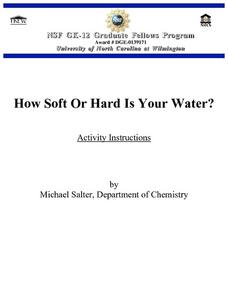Curated OER
A Comparison of Polymeric Liquids with Newtonian Liquids
Students perform several tests on liquids. In this general science lesson, students compare the properties of polymeric and nonpolymeric liquids. They explain the composition and importance of macromolecules.
Curated OER
Chemistry Lesson Outline
Students identify the different types of chemical bonds. For this chemistry lesson, students research a procedure on growing crystals in the lab. They perform the experiment and share results with the class.
Curated OER
It's the Slime Time
Students experiment to understand the basic concept of polymerization and to understand the dissolution theory. Student experiment with polymers to understand its behavior and the mechanical behavior of polymer networks.
Curated OER
How Soft or Hard is Your Water?
Young scholars test samples of water to determine how a chemical water softener affects water's ability to form suds. After collecting their data and analyzing their results, students answer follow-up questions about their lab.
Curated OER
Slime
For this chemistry worksheet, students make slime by following the directions given. Students read the 6 steps to complete the slime process and follow them.
Curated OER
Slimy cells
Students study the parts of a cell. In this chemistry lesson students complete an activity in which they make as much slime as they want.
Curated OER
Household Hazardous Waste Identification
Fourth graders learn about reduce, reuse, and recycle and identify household hazardous products. Students learn about less hazardous alternatives and complete an inventory of hazardous materials in a typical household.
Curated OER
Household Hazardous Waste Identification
Fourth graders discuss the concept of reduce, reuse and recycle. They identify products in their homes that are hazardous and discover alternatives to them. They examine the inventory of other classmates hazardous materials.
Other popular searches
- Borax Crystals
- The Borax
- Slime With Borax
- Borax and Glue
- Borax Slime Lab
- Growing Crystals Borax
- Dr. Seuss the Borax
- Dr Seuss the Borax
- Synthesis Reaction Borax
- He Borax
- Dr. Seuss's the Borax
- Rhyming Lessons the Borax









